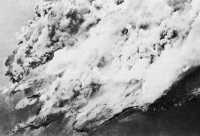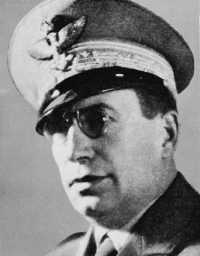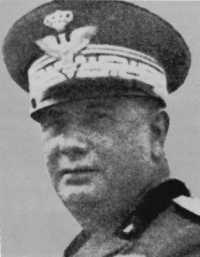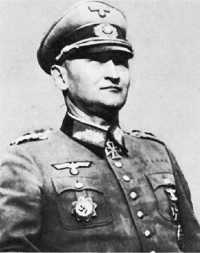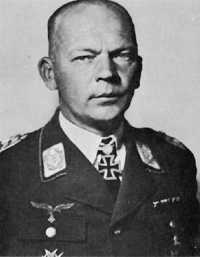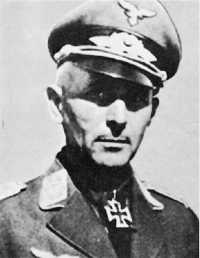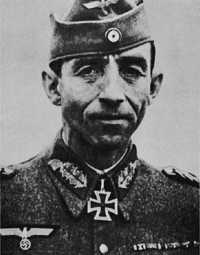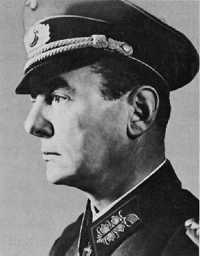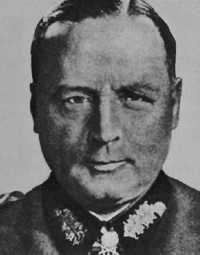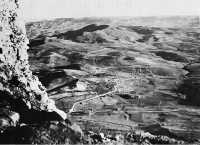Chapter 4: The Axis Situation
Pantelleria
A small island about eight miles long, five miles wide, Pantelleria is rugged, with sheer cliffs rising out of the sea. The few small areas of level ground were intensively cultivated except around the airfield, which could handle eighty single-engine fighter aircraft. About 120 miles southwest of Palermo, Pantelleria is about the same distance as Malta from Catania.
Since late 1940, the British had wanted to reduce Pantelleria in order to remove the air threat which it posed. But by the time the British could devote some attention and effort to the problem, the German Air Force had moved into Sicily, making the risks of assaulting Pantelleria too great. British plans lay dormant until the end of 1942, when they began to receive consideration.1 Still, seizing Pantelleria would not be easy, for by the spring of 1943 the island was a seemingly impregnable fortress garrisoned by about 12,000 troops, with underground aircraft hangars hewn from solid rock impervious to bombardment.
AFHQ began to look hard at Pantelleria in early February 1943, when General Marshall informed General Eisenhower that the U.S. Navy could not provide eight auxiliary aircraft carriers requested for air cover of the American assault on Sicily. Marshall suggested instead that Eisenhower seize Pantelleria for its airfield, from which Allied fighters could support the Sicily operation.2
Though Eisenhower at first was not impressed, he set his staff to prepare a plan to reduce Pantelleria, but only “if the capture became necessary.”3 The conclusion of the planners was unfavorable. Pantelleria posed difficult problems even if unlimited resources were available. With preparations for Sicily limiting available resources sharply, Pantelleria seemed altogether too tough. Pantelleria could be taken only at the expense of postponing the Sicilian assault, and planners felt that the importance of Pantelleria to the success of HUSKY was too small to justify delay.4
So the matter rested until May, when the invasion plan moved the entire Allied assault to the southeastern corner of Sicily. General Eisenhower again considered
seizing Pantelleria. He admitted that there were disadvantages in such an operation: possible heavy losses in men, ships, and landing craft, which could be ill afforded on the eve of the Sicilian invasion; the fact that a successful defense at Pantelleria would put heart into the Sicilian defenders at a time when “we sought to break it;” and the fact that the operation would point rather obviously to the next Allied move in the Mediterranean. Yet Eisenhower now saw great advantages in having the island: better air cover for the American landings; removal of a serious Axis threat to Allied air and naval operations during the Sicilian invasion; the use of Pantelleria as a navigational aid for Allied aircraft and for bases for air-sea rescue launches; denial of Pantelleria as a refueling base for enemy E-boats and submarines; and elimination of enemy radio direction finder and ship-watching stations to insure a better possibility of achieving tactical surprise for the Sicilian invasion.5
Intelligence reports were promising. Only five Italian infantry battalions, for the most part untested in battle, defended Pantelleria, and they were supported mainly by antiaircraft batteries manned by militia troops. The only evidence of the state of their morale was “the poor display of the antiaircraft gunners when our air forces raided on 8 May.”6
On 10 May, perhaps still stung by General Marshall’s rebuke on his “lack of adaptability,” Eisenhower decided to seize Pantelleria, but without expending heavily in men or matériel. To obviate a full-scale assault, Eisenhower thought of making the operation “a sort of laboratory to determine the effect of concentrated heavy bombing on a defended coastline.” He wished the Allied air forces “to concentrate everything” in blasting the island so that the damage to the garrison, its equipment and morale, would be “so serious as to make the landing a rather simple affair.” Constant artillery pounding on the defenders of Corregidor in 1942 seemed to have had that effect and Eisenhower wanted “to see whether the air can do the same thing.”7
The British 1st Infantry Division, supported by appropriate naval forces, was to follow the bombardment and seize and occupy the island. The smaller nearby Pelagian Islands—Lampedusa, Linosa, and Lampione—were also to come under attack.8
All three services established a headquarters at Sousse and went to work. Increasingly heavy air bombardments and a naval shoot soon reduced Pantelleria
Pantelleria under attack, “a hurricane of fire and smoke.”
to shambles. Enemy casualties were few in number, but damage to housing, roads, and communications was severe. By 1 June the port was in ruins, the town practically destroyed, and the electric plant knocked out. Shortages in water, ammunition, and supplies, plus the almost incessant explosions, began to have serious effects on morale. During the first ten days of June, more than 3,500 planes dropped almost 5,000 tons of bombs.9
On the morning of 8 June, members of the Italian garrison brought to the island commander some surrender leaflets dropped by the aircraft. As Supermarina proudly reported the incident to Comando Supremo, Pantelleria had not replied to the Allied ultimatum, Pantelleria would resist to the utmost.10
Again on 10 June the Italians refused to accept surrender. The single radio station working assured Rome that “despite everything Pantelleria will continue to resist.” Successive telegrams, as many as twenty that night, told of Pantelleria’s crumbling endurance, but none mentioned surrender.11
On the morning of 11 June, the Allied invasion fleet carrying the British 1st Division halted about eight miles off the harbor entrance of the port of Pantelleria. The ground troops loaded into assault craft. The weather was good, the sea calm. Only a few low-hanging clouds flecked the sky. Pantelleria itself was cloaked in the haze and dust raised by air bombardment earlier that morning.
The Italian island commander had followed his usual custom of holding a staff conference that morning, even though Allied planes were plunging the island into a “hurricane of fire and smoke.” Heavy smoke and dust clouds blocked a view of the ocean, and the island commander was unaware of the Allied fleet offshore. Discussion at the staff meeting soon showed everyone in agreement—the situation had become untenable because of lack of water, communications, ammunition, and also because of the danger of disease. Furthermore, no Axis planes remained on Pantelleria; help from outside could not be expected; and the 24,000 people on the island had about reached the end of their endurance. Since the commander had wired Supermarina several hours earlier that “the situation is desperate, all possibilities of effective resistance have been exhausted,” he ordered his air commander to display a white cross on the field. Because it would take almost two hours for the order to reach all the posts, the commander set the time for the cessation of hostilities at 1100. Shortly after he made his decision, the clouds opened and he saw the Allied ships.12
At about that time the landing craft started their final run to the beaches. There was a strange stillness, the only noise being the pounding of the assault craft, the drone of fighters orbiting overhead. Cruisers started to fire at shore battery positions around 1100, and thirty minutes later escorting destroyers added their fires. No reply came from the island. At 1135, U.S. Flying Fortresses bombarded the island in “the most perfect precision bombing of unimaginable intensity.” At 1145, the assault echelon commander released his craft. By noon British troops were ashore. Shortly afterwards white flags appeared on many of the buildings.13
Lampedusa had also refused the Allied surrender offer, the island commander notifying Rome that “bombardments are continuing without interruption, both from the air and from the sea. Air Support required urgently.” Instead of help, only words of intended cheer arrived: “We are convinced that you will inflict the greatest possible damage on the enemy. Long live Italy.” Disappointed, resentful, feeling that they had done their duty, the members of the garrison, after being ordered to do so by the island commander, raised white flags in surrender.14 Linosa fell the next day, 13 June. The Allies found Lampione unoccupied.
Allied intelligence had overestimated the will to resist of the defending garrisons.
Despite Fascist propaganda, Pantelleria and the Pelagian Islands were hollow shells manned largely by over-age and inexperienced individuals, many of whom had their homes on the isles. When the Allies attacked, quite a few succumbed to the temptation of looking after their families instead of remaining at their posts. But against the power of the Western Allies there was probably little they could have done with their inadequate and obsolete equipment.
On 20 June British aircraft began to operate from the field at Lampedusa, and six days later a group of U.S. P-40 fighters was based at Pantelleria.
Eisenhower’s laboratory experiment had been eminently successful. Pantelleria and the Pelagian Islands gave the Allies a safer channel for shipping in the central Mediterranean and, more important, valuable airfields closer to Sicily and the Italian mainland.
Growing German Strength
Allied seizure of Pantelleria furnished no sure indication to Axis intelligence of the future course of Allied operations in the Mediterranean. Whether the attack on the outlying Italian islands was preliminary to an attack on Sicily or whether it served a plan of greater scope was not clear.15
What was more than clear was the speed with which Pantelleria and the other islands had fallen. The rapid collapse showed that the Axis had definitely lost the initiative, for the Axis Powers could do little more than await invasion elsewhere, prepare to counterattack, and hope to repel the landings. Naval forces could react with only light surface craft and submarine activity against Allied shipping. Air forces were reduced to purely defensive efforts. Moreover, Pantelleria seemed to prove to Mussolini that air bombardment, like artillery, conquered ground and allowed the infantry to occupy it. Considering the fact that the Allies were blessed with a superiority of artillery and other equipment, the inference was evident.16
To the Italians, the loss of Pantelleria was depressing. If this was the start of the battle for Sicily, Sardinia, or the Italian mainland, it was a poor beginning. As the Italian people awakened increasingly to the realization that they had lost the war, defeatism spread.17
To the Germans, loss of the islands meant not only a military defeat and a blow to Axis morale, it served also as an indication of the performance they could expect in the future from their Italian allies. The Germans could not understand why the outlying islands had not been sufficiently stocked with the supplies of war. It was difficult for them to comprehend why the Italians, fighting on their own soil, had offered so little resistance. Did the speedy fall of Pantelleria foreshadow the course of future operations in the Mediterranean?18
If the capitulation of Pantelleria made the Germans feel that they could expect no resurgence of Italian morale in defense of the homeland, it made Comando
Supremo much more willing to accept German help in the form of divisions to defend Italian soil.19
Just before the fall of Pantelleria, Ambrosio, increasingly worried over defending Italy, had reluctantly concluded that two robust and highly mobile German divisions were necessary for the defense of Sicily. But if the Hermann Göring Division moved to Sicily, southern Italy would be exposed, for the 16th Panzer Division could not act as mobile reserve against landings on both east and west coasts.20 Ambrosio discussed these problems with Kesselring and Rintelen on 1 June. And when Kesselring forced the issue by asking, “Do you request me to inquire with the OKW to see if there is another division in addition to the 16th Panzer Division?” Ambrosio admitted that that was what he meant.21 The Italians were now willing to accept five German divisions, the number Hitler had originally offered to Mussolini.
Believing that the Germans could defend Italy if the Italians cooperated, having great faith and confidence in Mussolini though suspicious of the Italian military command, Kesselring asked Ambrosio whether the Italians needed more antiaircraft protection for the arterial railway lines and the power dams. Ambrosio did not commit himself at once, but a month later a formal, written request reached Kesselring. The Italians asked for antiaircraft guns and also for German crews. These would not arrive in Italy until August; by then they would be too late.22
Meanwhile, Kesselring returned to Rome on 8 June after visiting Hitler’s headquarters. Hitler had told him that he was willing to send more planes, tanks, reconnaissance units, self-propelled guns, and troops to Italy. All the Italians had to do, Hitler said, was to have the Duce and Comando Supremo ask for them.23
But Ambrosio was in a quandary. If Mussolini was really going to break with the Germans, the fewer German troops in Italy the better. If, on the other hand, Italy was to oppose an Allied attack, more German troops were necessary.
More were available, as Kesselring pointed out to Ambrosio on 11 June, the day that Pantelleria surrendered. But when Kesselring said that both General Hube, the XIV Panzer Corps commander, and the Italian commander in Sicily thought that additional German troops were needed, Ambrosio professed to be unconvinced. He wondered whether the 16th Panzer Division might be sent to Sardinia, the Hermann Göring Division held in southern Italy. Kesselring objected on two counts: Sardinia was inappropriate terrain for employing an armored division—the 16th Panzer Division should therefore stay on the
mainland; and one mobile German division was insufficient as a reserve in Sicily because two areas of attack were likely, in the west and in the southeast. Kesselring urged that Ambrosio, if he planned to request additional German forces, make his requests promptly so that OKW would have adequate time to prepare the divisions and move them. Ambrosio replied with some irritation that he was not prepared to make a formal request, though he said he would submit a complete statement of Italy’s requirements within a few days.24
The fall of Pantelleria and the Pelagian Islands, which prompted Hitler to order both Sardinia and Sicily reinforced, caused Ambrosio to change his mind. When Ambrosio met again with Kesselring on 12 June, he was in a completely different mood. He acknowledged the validity of not moving the 16th Panzer Division to Sardinia, though he wanted to be sure that there were adequate guns and tanks on the island. Upon learning that the Germans intended to send additional strength to Sardinia, Ambrosio agreed to keep the 16th Panzer Division on the mainland. Kesselring then announced that the Germans had another motorized division—the 3rd Panzer Grenadier—available and, if requested, it could be promptly moved to southern Italy, making possible the transfer of the Hermann Göring Division to Sicily. Ambrosio agreed to this proposal and to another by Kesselring that the reconnaissance battalion of the Hermann Göring Division proceed to Sicily at once. He also agreed that the 3rd Panzer Grenadier Division might move into Italy immediately. Kesselring then said that if the Italians wished, the Führer could send a fourth division for the defense of the Italian soil, making a total of six German divisions in Italy. Ambrosio replied that he would have to study the distribution of divisions carefully, and would give a formal answer in a few days.25
A few days later professional advice from field commanders overcame Ambrosio’s reluctance to admit additional German troops to Italy. After a very pessimistic report by the Italian commander in Sicily on 14 June, Comando Supremo three days later requested OKW to send to Italy two additional armored or motorized divisions. OKW complied by selecting the 29th Panzer Grenadier and the 26th Panzer Divisions, units that in mid-May had been earmarked for the occupation of northern Italy under Plan ALARICH.26
By the end of June 1943, five German divisions, in whole or in part, were in Italy; two more divisions were about to enter the country; the XIV Panzer Corps headquarters was already in Italy; and agreement had been reached for the arrival of another corps headquarters (the LXXVI Panzer Corps). Italy was beginning to resemble an occupied territory.
The Defenses of Sicily
Recognizing the impossibility of constructing and manning effective fortifications
along the entire extensive Italian coast line, Comando Supremo had originally decided to concentrate the defenses on the major islands, plus part of the southern mainland. During the winter of 1942–43, the Italians began to give precedence to the defenses of Sardinia, the most likely Allied target. Around March 1943, they started to make special efforts to brace Sicily.27
German coastal defense advisers, who had supervised the construction of the Atlantic Wall on the Channel coast, arrived in Italy in the spring of 1943, and one group went to Sicily to make recommendations for its defense. Though Italian fortification experts, some of whom had visited the Atlantic Wall, were impressed and anxious to duplicate it, the Italians lacked the resources to build and man such a fortified belt. Despite strenuous efforts to improve and extend the few existing fortifications on the coast of Sicily, the Italians made little progress.28
The Italian Sixth Army had been stationed on Sicily since the autumn of 1941. Generale di Corpo d’Armata Comandante Designato d’Armata Mario Roatta, former chief of staff of the Italian Army, took command in February 1943 and assumed responsibility for part of Calabria as well as for Sicily. Roatta controlled almost a dozen divisions under two corps headquarters, an air reconnaissance force, and, through liaison, certain German units. With only partial control over the territorial antiaircraft defenses manned by the Fascist Militia (headquartered at Palermo), Roatta had no control over ground militia, naval, and air forces on Sicily. He had no direction of the units under the civilian prefects of the provinces. To coordinate his dispositions with the plans of various independent headquarters, Roatta had to rely on liaison. In all, the Italian command authority was divided among seven military and nine civilian agencies. Except for the naval bases and a few ports, the island in early 1943 was not on a wartime basis.29
Shortly after assuming command, Roatta obtained a degree of unified command by having Comando Supremo give his Sixth Army headquarters the additional title of Armed Forces Command, Sicily.30 Roatta then became responsible for the tactical commitment of the Italian Army, Navy, Air, and militia elements, plus the German ground troops in Sicily and in southern Calabria. Through a high commissioner for civilian affairs, Roatta also assumed control of the civilian administration of the nine provincial prefects. The relatively small German air and naval elements remained under autonomous German control.31
Roatta next requested troops and weapons to bring his ground forces up to wartime strength. He wanted manpower and materials so he could construct
General Roatta
General Guzzoni
additional fortifications, improve communications, make possible the evacuation of the civilian population from battle areas, and stockpile supplies and food. But the men and materials he received were far below the amounts he considered minimum requirements.
Roatta nevertheless set soldiers and civilians to work to enlarge and improve the defenses on the beaches and at vital points on the main highways. He also began to construct a belt of fortifications and obstacles twelve to fifteen miles behind the beaches in order to contain Allied forces that might get ashore. He assigned each military unit a specific coastal sector for defense.32
After serving as commander for three months, Roatta issued a proclamation that the population interpreted as a slight to Sicilian patriotism.33 This, added to changes recently made in the Italian high command, prompted Comando Supremo to appoint Roatta chief of the Army General Staff (Superesercito) and to nominate Generale d’Armata Alfredo Guzzoni in his place.
Guzzoni’s appointment was somewhat surprising, for he was sixty-six years old and had been in retirement for two years. Furthermore, he had never been to Sicily, nor had he ever displayed interest in the island and its military problems. Guzzoni’s chief of staff, Col. Emilio
Faldella, a young and capable officer, appeared a good choice, but he, too, was a stranger to Sicily. Nor had Faldella, contrary to the usual Italian practice of keeping a commander and his chief of staff together, ever served with Guzzoni.34
The Italian command structure was not rigid but rather relied on cooperation and coordination among commanders. An officer’s ability to engage in teamwork was therefore important. Similarly, unit organization was flexible. Commanders formed small groups of varied composition to meet various situations, without formal reassignment or reorganization, designating them by location, the name of the commander, or by letters of the alphabet. When the need disappeared, the task force was informally dissolved and its elements returned to the original units.35 These features were particularly significant in Sicily where an army headquarters had become responsible for employing a diversity of forces, Italian and German. Despite his unified command, Guzzoni exercised real control in great part only through liaison and mere recommendations.
The coordination of German and Italian units on Sicily varied, with the result that the German elements were partially under German and partially under Italian control. In due course, parallel channels of communication and command developed, one from Guzzoni to Comando Supremo and Mussolini, the other from the individual German headquarters on the island to OB SUED. Liaison between Kesselring and Ambrosio, chief of Comando Supremo, re-established coordination at that level.
Part of this setup was the outgrowth of the organization established during the North African campaign. Hitler’s predilection for dual control channels, mutual distrust between Italians and Germans after their defeat in Tunisia, and the need for flexibility brought about considerable vagueness, not to say confusion, in the command organization of the Axis partners.
At the close of the North African campaign, when an Allied attack on Italy appeared in the offing, Kesselring was the main connecting link between Hitler and OKW on one hand and Mussolini and Comando Supremo on the other. Kesselring had controlled the German armed forces in Italy and the central Mediterranean through German representatives in Italy who also maintained liaison with Comando Supremo. Now, for better liaison, Kesselring established within Comando Supremo a mixed staff of Germans and Italians headed by his own chief of staff, General der Artillerie Siegfried Westphal.36
In mid-June, when Kesselring relinquished his air command to Feldmarschall Wolfram Freiherr von Richthofen but
retained his prerogatives as Commander in Chief South, he emerged as the strongest German officer in Italy. As theater commander, unifying in his person control of all the German armed forces in Italy, Kesselring was Hitler’s representative on all questions concerning the conduct of the war in the central and western Mediterranean areas. Guzzoni found Kesselring a typical German officer who had a determined though courteous and conciliatory manner and who promised effective cooperation. Two of Kesselring’s major problems were trying to reconcile the sometimes conflicting demands of German commanders and Italian prerogatives and trying to combat Italian pessimism on defending Sicily.
Guzzoni, like his predecessor, saw little strength in the Sicilian defenses. The coastal battalions, he reported to Comando Supremo, were composed of men of older age groups, often badly commanded, and in some instances covering defensive sectors up to twenty-five miles in length. Guzzoni, lacking antinaval guns and deficient in all other types of artillery, had but one antitank gun for each five miles of coast line. As against a daily need of 8,000 tons of supplies to meet civilian and military requirements, he was receiving 1,500 to 2,000 tons. The morale of the civilian population was very low because of Allied air bombardments and the restricted food supply—the rationing system had broken down, and blackmarket operations were widespread. The people wanted only an end to the war. If resolutely committed, Guzzoni estimated, his forces might hold back the initial Allied landings but could not check successive attacks. Reiterating Roatta’s earlier demands for more artillery and tanks, he urged in addition the immediate transfer of the Hermann Göring Division to Sicily.37
Except at the naval bases, no continuous system of coastal defenses existed. Obstacles, mine fields on and off shore, antitank ditches, and concrete fortifications appeared only at widely separated points. Many fortifications lacked garrisons or weapons, many were poorly camouflaged and lacked troop shelters. In the interior, only a few roadblocks were ready, and most of these were inadequate. On the highway from Licata to Campobello, for a distance of more than twelve miles, for example, the entire antitank defense consisted of one 47-mm. gun. The inland blocking line consisted of a beautiful colored pencil mark on a map.38
The three naval bases on Sicily were equipped with antinaval and antiaircraft artillery, and their seaward defenses were effectively organized. Their weaknesses were the undependable militia who manned many of the guns, the age of the guns, and their small caliber and short range. The bases had little defense against landward attack.39
Though the naval commanders remained in control of technical, administrative, and training matters, Guzzoni was responsible for the defense of their bases. In the event of a ground attack, he was to send army reinforcements. Because of the importance of liaison to the command channels, the poor condition of signal communications caused serious
General Rodt
Field Marshal Von Richthofen
General Conrath
apprehension among all the commanders concerned.40
Expecting the Allies to try to seize airfields quickly, the Italians started work to surround the airfields with obstacles and strongpoints manned by infantry supported by artillery. They mined all landing strips to render them useless in the event of loss.41
The heart of Sicily’s defenses consisted of forces under the two corps commanded by the Sixth Army: six coastal divisions, two coastal brigades, one coastal regiment, and four mobile divisions. In addition, two mobile German divisions were in Sicily by the end of June.
The Italian units, numbering some 200,000 men (including the airfield defense troops), generally had a poor combat effectiveness. The coastal units especially had antiquated or deficient armament and virtually no transportation, they were badly commanded in many cases, and their indigenous personnel, as much as 75 percent in some units, reflected the low morale of the Sicilian population. Tactical groups created from division elements and from corps reserves were deployed relatively close to the beaches to support the coastal units, and these had some mobile elements.
The special groups organized to defend the airfields consisted usually of one infantry and one artillery battalion per airfield, but they were soon augmented by mobile elements—light tanks, self-propelled guns, armored cars, motorized infantry and artillery, and various engineer units—and they served as a mobile reserve for general defensive operations.
The four Italian mobile divisions, the best of the Italian combat forces on the island, were none too good. The Aosta and Napoli Divisions, largely composed of Sicilians, were poorly trained. The Assietta Division was somewhat better. But all three operated under reduced
General Von Senger
Colonel Baade
General Hube
Tables of Organization, and their artillery and other equipment were for the most part antiquated. Only the Livorno Division was at full strength and had organic transportation. In all four divisions, artillery ammunition was generally in short supply or nonexistent, signal communications varied from poor to inadequate.42
The two German divisions made quite a contrast. The Division Sizilien, redesignated the 15th Panzer Grenadier Division on 29 June and commanded by Generalmajor Eberhard Rodt, was ready for commitment. It had supplies for twenty days of operations. Though not completely mobile, the division could move relatively quickly with its organic equipment.43 The Hermann Göring Division, under the command of Generalmajor (later, General der Fallschirmtruppen) Paul Conrath, moved from southern Italy into Sicily during June. It was somewhat deficient in infantry, but was also well trained and equipped, although the process of combined training did not effectively begin until the arrival of the division on Sicily. Airborne elements and other German units in southern and central Italy, if necessary, could also be employed in the defense of Sicily.44
Though operational command of German units—totaling some 30,000 men –
remained in Italian hands, Hitler and the OKW sometimes sent instructions directly to local commanders, who frequently communicated directly with the OKW. The Italians soon came to accept the view that obtaining German cooperation was preferable to a strict imposition of Italian authority.45
The XIV Panzer Corps headquarters, located in southern Italy, functioned under OB SUED to administer and supply the German units in Sicily. The Italians could hardly object to this, and the Germans had a headquarters ready to take over active operations should such a course of action become necessary or desirable. General Hube had commanded the corps in Russia and had received high praise for his performance.46
Late in June 1943, the Germans introduced another officer into the command picture, Generalleutnant Fridolin von Senger und Etterlin, who became liaison officer with the Sixth Army headquarters and responsible for coordinating the employment of German troops committed on the island.
The Italian battle fleet, stationed at La Spezia and far removed from Sicily, was seriously reduced in strength, lacked radar and aircraft carriers. It could be effective against an Allied armada only with adequate air protection, which was not available. Furthermore, it needed twenty-four hours to reach the waters off Sicily. For these reasons and because of apprehension that the first major battle of the surface fleet might well be its last, Comando Supremo decided late in May to commit the naval forces in the defense of Sicily only if an extraordinarily good opportunity presented itself and if sufficient fuel oil was on hand to support the operation. Comando Supremo also directed the small naval craft stationed in Sicilian and Sardinian waters to remain in defense of their home stations rather than join forces in the event one or the other island came under attack.
The most important German vessels consisted of a landing craft flotilla at Messina. Plans to supplement the few German submarines in the Mediterranean had to be abandoned because the passage through the Strait of Gibraltar had become increasingly difficult.47
The better to organize their services of supply across the Messina Strait, the Germans in May unified a number of Army, Navy, and Air Force transportation installations into a single headquarters. Eventually known as Commandant Messina Strait under Col. Ernst Guenther Baade, it was responsible for ferry service, depots, and antiaircraft defenses, controlling in the latter function some seventy antiaircraft batteries on the Italian mainland and on Sicily to guard the strait.48
The Italian Air Force was in a hopeless situation because of obsolete and inferior aircraft. After the fall of Tunisia, Allied air attacks on Sicilian airfields became so intense that toward the end of May the Axis withdrew its bombers to the mainland. Italo-German coordination of air matters was poor, the German fighter units taking over the protection of Sicily from their own fields as though the Italians were not even present. But in a series of twenty-one air battles from the latter half of May through the early days of July, the Germans sustained heavy losses. Göring, who recognized what was happening but not the cause, brought heavy pressure to bear on the German Second Air Force, calling for incessant commitment of long-range bombers and fighters. But the German aircraft were not able to match the speed and armament of Allied planes. Göring added insult to injury by sending a special message to the fighter pilots of the Second Air Force:
Together with the fighter pilots in France, Norway, and Russia, I can only regard you with contempt. I want an immediate improvement and expect that all pilots will show an improvement in fighting spirit. If this improvement is not forthcoming, flying personnel from the commander down must expect to be remanded to the ranks and transferred to the Eastern front to serve on the ground.49
Though Generaloberst Hans Jeschonnek, chief of staff of the OKL, visited Kesselring and learned that decisive numerical and technical inferiority of German aircraft to those of the Allies was at the bottom of German air failure, Göring stubbornly refused to admit that the responsibility was his own.
Because of air and naval weakness, the whole burden of the defense of Sicily fell on the Axis ground forces. Misunderstandings and misinterpretations among Italian and German commanders further aggravated the situation.50
Despite inadequate forces, matériel, and fortifications to defend the entire coast, the Italians felt impelled to fight at the water’s edge. Small tactical reserves were to stand ready close behind the coastal defense forces, and mobile reserves in centrally located positions farther to the rear were to be available to counterattack as soon as the point of the main Allied attack became apparent. Because the Italians considered their coastal units incapable of repelling a landing, the commitment of these units to stubborn defense meant their sacrifice. Since reserves were few, the commanders hoped to increase their effectiveness by holding them together and ready to move to any one of a number of widely separated points. The great drawback in this concept was the lack of sufficient mobility on the part of most units. The German units, with far greater mobility, could form the only effective reserve. Appreciating this, Kesselring, late in May, instructed German commanders to counterattack as soon as they knew the location of the main Allied attacks without waiting for orders from Guzzoni’s headquarters.51
Guzzoni’s headquarters was near Enna, fairly close to the center of the island. The Italian XVI Corps under Generale di Corpo d’Armata Carlo Rossi was to defend the eastern half of the island; the Italian XII Corps, first under Generale di Corpo d’Armata Mario Arisio, later under Generale di Corpo d’Armata Francesco Zingales, was assigned the western half of the island. By the latter part of May the coastal units were in their assigned sectors, and the Sixth Army had attached the Italian mobile divisions to both corps for commitment in their respective areas—Aosta and Assietta under XII Corps in southwest Sicily, Napoli near Catania, and Livorno near Gela under XVI Corps. In the Sixth Army reserve and reinforced by a self-propelled Italian regiment of artillery, the 15th Panzer Grenadier Division split its forces into three regimental teams—Group Ens in the southwest; Group Fullriede in the southeast; and Group Koerner in the Enna area as an unassigned reserve.52
General Rodt, the 15th Panzer Grenadier Division commander, represented by his chief of staff, discussed with Guzzoni the possibility of holding the mobile reserves closer to the coast. He proposed moving two of his regimental groups quite close to Gela and Catania, the third to the west but keeping it ready for immediate transfer to the east if necessary. Assuming that the Italian coastal divisions would barely delay the attackers, and estimating that the Allies would land in several different places before moving inland in pincer movements, Rodt wanted to counterattack immediately and eliminate each landing in turn. He asked Guzzoni to attach to his division the mobile groups organized to defend the airfields. Convinced that the airfields would be immediately threatened, Guzzoni refused.
Admitting that the southeastern corner of Sicily was vulnerable and that the Napoli Division lacked sufficient mobility to move in time to any area under attack, Guzzoni, contrary to the German view, doubted that the Allies would space their landings in such a way as to permit counterattacking forces to execute successive operations. He nevertheless issued a revised plan on 9 June. The Aosta and Assietta Divisions under the XII Corps and the Napoli Division, under the XVI Corps were to remain in their previously assigned areas. But because General Guzzoni was very conscious of the German determination to attack immediately, he feared that the German units, representing his only truly mobile reserves, would escape his grasp. Deeming it wise to have some Italian troops firmly in hand, he transferred the Livorno Division to army reserve and moved it closer to his Sixth Army headquarters. The German elements remained generally in place. But additional units arriving in Sicily formed a fourth reserve force as Group Neapel in the center.53
Looking South from the heights of Enna, site of General Guzzoni’s 6th Army Headquarters
Transfer of the Hermann Göring Division to Sicily as the second German division created a new problem. The German commanders in Sicily wished to use the 15th Panzer Grenadier Division in the eastern half of the island where they saw the greatest Allied threat and where the division was well acquainted with the terrain—where, in fact, the division had executed a map maneuver based on a simulated Allied landing in the Gela area. They therefore wanted the Hermann Göring Division, which was not so far advanced in combined training as the 15th, committed as a whole in the western part of the island, where the threat seemed not so great.54
Guzzoni, convinced that the main Allied attack would hit the eastern coast near the southeastern corner, wanted to hold both German divisions together as a mobile reserve in the eastern part of Sicily. He envisioned the Livorno and Napoli Divisions fighting delaying actions until the two German divisions could mount a counterattack and strike.
Kesselring reiterated the German view that an invader was weakest when he left his assault boats and waded ashore. He therefore wanted the reserves very close to the coast because he believed that the Axis forces were too weak to eliminate beachheads once they were well established, and because he was concerned that Allied air might retard daylight movements of the reserves on the narrow, winding, Sicilian roads. Furthermore, reserves stationed inland would literally have to come down the mountains in daylight and would thus present good targets for Allied naval gunfire. Reserves stationed close to the coast would be spared long and difficult approach marches and casualties from Allied air attacks.55
The decision reached was to commit the German divisions as much as possible as complete units, one in the east, the other in the west. The Hermann Göring Division was to assemble in the southeastern area in Sixth Army reserve but was to be available for use by the XVI Corps with Guzzoni’s permission. Group Koerner of the 15th Panzer Grenadier Division, located near Catania, was to be attached to the Hermann Göring Division. Group Ens of the 15th was to remain in the west under direct army control. Group Fullriede, integrating Group Neapel into its organization, would be in the center near Caltanissetta.
Guzzoni then had as the Sixth Army reserve the augmented Group Fullriede and the Livorno Division. This fully motorized reserve near Caltanissetta would be ready for commitment toward Catania, sixty miles to the east; Gela, thirty miles to the southeast; Licata, thirty miles to the south; and Agrigento, thirty miles to the southwest.
When the Hermann Göring Division established its headquarters at Caltagirone, twenty miles northeast of Gela, it assembled about two-thirds of its units in the area. The other third combined with Group Koerner of the 15th Panzer Grenadier Division to form Group Schmalz and went into position near Catania. The 15th Panzer Grenadier Division headquarters and Group Fullriede moved into the western part of Sicily.
Kesselring, though expecting the main Allied landings to take place on the eastern or southern coasts, was still preoccupied
with a possible secondary attack in the west. He proposed transferring Group Fullriede to the western sector, leaving Group Neapel in the Caltanissetta area. He also proposed moving the German units closer to the coast than the Italians contemplated, and he suggested concentrating them in the south central part of the island.
Guzzoni agreed. On 26 June Kesselring summarized his concept of repelling an invasion: the battle was to be fought at the coast line by coastal units supported by local reserves under division and corps control; mobile reserves—the four Italian mobile divisions—relatively close to the coast in small groups, were to be ready to pounce as soon as the Allies set foot on shore; finally, the German divisions were to clean up.56
At the end of June, then, the Aosta and Assietta Divisions and the bulk of the 15th Panzer Grenadier Division were in the west; the Napoli, Livorno, Hermann Göring Divisions, and one-third of the 15th Panzer Grenadier Division were in the south and east. (See Map II)
Expecting the Allies to land in several quite separate places, the Axis commanders planned to counterattack the landings immediately, wipe them out one after another, and prevent the establishment of a continuous front. When Guzzoni committed his mobile reserves, he hoped to do so at that “fleeting moment” when the main invasion sites were evident but the individual beachheads were not yet fully merged.
The axis commanders believed they had several more weeks to complete their final preparations, for they expected the Allies to attack about the middle of July.57
